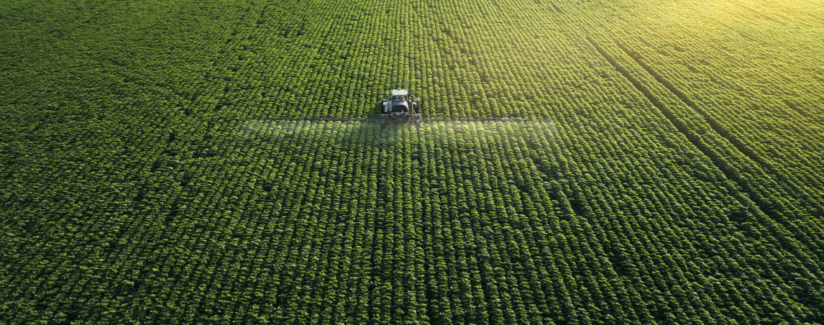
Sustainability: What If Farmers Did Not Use Pesticides?
04/30/2020
Farmers use many tools to produce the food that ends up on our plates. Among them are crop protection products, also known as pesticides. Crop protection helps control weeds, pests and diseases that starve food crops of the nutrients, sunlight and water needed to thrive.
Pesticides are part of a much larger conversation about sustainability. Should we be using them? What are the tradeoffs when it comes to our environment and food safety?
Sustainability is the principle of meeting the needs of the present without compromising the ability of future generations to meet their needs. For food, sustainability includes a wide range of factors such as water use, animal well-being, worker care and soil conservation. Learn more about Optimizing Sustainability.
In this series about sustainability, we’ve been looking at the tradeoffs with various food production practices. We reached out to experts to learn about the sustainability tradeoffs related to pesticides.
“Pesticide” is a general term that covers three broad areas of crop production, explains Jeff Graybill, an Extension Educator in Agronomy at Penn State University. “Insecticides control worms, bugs and other insects that can easily consume crops in the field or grains and food in storage. Herbicides will control and prevent weeds from overcoming the crop and lowering the harvest. And fungicides prevent and control diseases which attack our crops,” he said.
Tim Durham teaches agronomy and agricultural sciences at Ferrum College. He’s also part of his family’s fifth-generation vegetable farm on Long Island, New York.
“Since cropping is our livelihood, we’re motivated to protect our investment … we’re constantly evaluating new markets, crops and production systems. We pride ourselves on staying nimble when it comes to pest management,” Dr. Durham said.
What are the different types of crop protection and why are they used?
Chemical sprays are one method used to manage weeds and insects, but there are several approaches.
“Many farmers in the U.S. practice integrated pest management (IPM). This means that farmers use a variety of methods to grow and protect the crop and will only choose chemical control when it is the better option. Other IPM tools include things like crop rotation, better plant genetics (disease and insect resistance) and natural predators,” Graybill said.
Most farms use a combination of practices to protect crops from weeds and insects, Dr. Durham said.
“We use knowledge about pests to exploit their vulnerabilities. This can include a spray – an informed one – but it also draws from a versatile toolbox of alternative approaches, any of which can be mixed and matched to optimize the effect,” he said.
Some additional, non-chemical options include:
- Biological: The use of “good” bug and microbe mercenaries to hunt pests.
- Cultural: Make the environment less hospitable for pests.
- Physical/Mechanical: Exclude troublemakers when possible, or grind them up with a disk or plow when they’re in a vulnerable life stage in the soil.
- Genetic: Use plant varieties that just aren’t appealing to pests.
- Regulatory: Coordinate with trade partners to make sure only clean produce (no pest stowaways) cone in, also quarantine when necessary.
What would happen if farmers didn’t use crop protection?
Pests – weeds, insects and fungus – are the greatest threat to growing any crop. Without pesticides, some crops could not be grown on a large scale, so our diets would not be as diverse. According to Dr. Durham, without pesticides, fruits and vegetables would be stunted, riddled with injuries and contaminated with microbes, contributing to food waste.
Without crop protection, food would also be more expensive as more of it would be lost to pests. According to Crop Life International, even with the use of modern crop protection products, 20 to 40 percent of potential food production is lost every year to pests.
“Pesticides provide some measure of predictability in the otherwise unpredictable world of farming, helping to stabilize commodity prices and keeping prices low in the grocery aisle. It’s one reason we spend a tiny fraction of our disposable income on food,” Dr. Durham said.
How do pesticides affect the environment?
There are tradeoffs to using pesticides, to using organic methods or to using nothing at all. Proper pesticide use can help protect part of the environment.
“They allow us to maximize production on the smallest footprint of land. This is called ‘land sparing.’ If we decided to forego pesticides, we’d need to appropriate a much larger chunk of land to do the same job and land that happens to be the most biodiverse and at-risk,” Dr. Durham said.
Efficiently using farmland – growing more food on less land – also protects forests and wildlife habitats from being cultivated. For instance, farmers who do not use herbicides to manage weeds in their crops can instead use tillage, which increases soil erosion and contaminates water sources.
“Fungicides and bactericides can make food safer to eat by reducing toxin levels,” Dr. Durham said. “How? Microbes occupy wounds made by pests. In the process, they produce dangerous toxins. It’s their biology – and also potentially. double jeopardy for consumers.”
“Chemical weed, disease and insect products often require much less time, equipment and energy than traditional production practices; thereby generating a lower carbon footprint and environmental benefits,” Graybill said.
But using chemical pesticides does involve some risk. The compounds are designed to kill a living organism such as a microbe, weed or insect, so they need to be used responsibly, Graybill said.
Some crop protection chemicals have a negative impact on beneficial insects, such as bees and butterflies. The agricultural industry is researching ways to reduce the negative impact. Some of the older, more toxic compounds have been banned and replaced by newer ones that are more targeted to specific species.
Learn more about pesticides and the environment.
As we evaluate tradeoffs in this series, we see that pesticides can have environmental risks because they kill certain plants and insects. Crop protectants also benefit the environment by reducing the amount of land, water and fertilizer needed to grow crops, which protects wildlife areas and reduces greenhouse gas emissions.
Is my food safe from pesticide residues?
Pesticides are regulated in the United States to be sure that they are as safe as possible for people and the environment.
“The United States has an extensive regulatory system, and whether it’s household chemicals or agricultural herbicides and insecticides, all chemicals go through extensive toxicology testing to look at the benefits and the risks of the product. This is especially true of pesticides used on food crops,” Graybill said “Since these chemicals are designed to kill a specific weed or pest, they must be respected, so when looking at human and animal health implications, regulatory agencies have very stringent standards.”
All foods, whether they are grown with conventional farming or organic methods, are regulated and safe. Even those on the Dirty Dozen are well below the acceptable threshold for residues. This Food Safety Calculator shows how much food a person can consume without experiencing adverse effects of pesticides.
“Any pesticide that comes to market must be approved and certified by the EPA, USDA and FDA. Toxicology data is peer-reviewed and is combed over very intensely. The government agencies then make a determination if there are any negative impacts and whether those negative impacts are outweighed by the good that the chemical will do,” Graybill said in a previous post on Best Food Facts.
Learn more about pesticides and food safety.
What are alternative methods of crop protection?
Organic methods are often considered more natural. USDA certified organic foods are produced in compliance with National Organic Program (NOP) standards
Organic does not mean that foods are pesticide free.
“It means only that the product was produced according to the standards of the NOP. While organic growers are commonly committed to using limited to no pesticides, they can—and often do—use pesticides allowed under the NOP standards,” said Dr. Paul Vincelli, Extension Professor and Provost’s Distinguished Service Professor, University of Kentucky.
Often conventional – or non-organic – farming involves using natural practices, Dr. Durham said.
“Organics suggests that old standbys like crop rotation and fallowing (field resting) are somehow organic exclusives, when they’re clearly not. Some practices never go out of style. Conventional growers use them regularly, melding the old with the new,” he said.
Following all regulations, using pesticides according to the label and also using integrated pest management can reduce the risks of pesticide use.
“Farmers proudly eat what we grow. We have full confidence in our practices and food safety,” Dr. Durham said.
Various types of pesticides are used to protect crops from weeds, insects and microbes. The decision to use chemicals, non-chemical methods or a combination of both approaches results in tradeoffs that can affect food affordability, food waste, land use and carbon footprint.



























